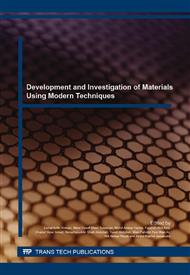[1]
J.C. Lai, W.A. Wan Abdul Rahman, W.Y. Toh, Characterisation of sago pith waste and its composites. Indust. Crops Products. 45 (2013) 319-326.
DOI: 10.1016/j.indcrop.2012.12.046
Google Scholar
[2]
R.S. Singhal, JF Kennedy, SM Gopalakrishnan, A Kaczmarek, C. J. Knill, P. F. Akmar (2008). Industrial production, processing, and utilization of sago palm-derived products. Carbohyd. Pol. 72: 1-20.
DOI: 10.1016/j.carbpol.2007.07.043
Google Scholar
[3]
S. Abdul Aziz, (2002). Sago Starch and Its Utilisation. J. Biosci. and Bioeng. 94: 526-529.
Google Scholar
[4]
S. Sadhasivam S. Swaminathan , K. Lin KF (2009). A prototype of proposed treatment plant for sago factory effluent. J. Cleaner Production 17: 1363-1372.
DOI: 10.1016/j.jclepro.2009.03.021
Google Scholar
[5]
D.S. Awg Adeni, Abd Aziz S, Bujang K, Hassan M. A (2010). Bioconversion of sago residue into value added products. African J. Biotechnol. 9(14): 2016-(2021).
Google Scholar
[6]
M. Igura, Okazaki M (2010). Cadmium sorption characteristics of phosphorylated sago starch-extraction residue. J. Hazardous Mater. 178: 686-692.
DOI: 10.1016/j.jhazmat.2010.01.142
Google Scholar
[7]
X. W. Tan, Romainor AN, Chin SF, Ng SM (2014). Carbon dots production via pyrolysis of sago waste as potential probe for metal ions sensing. J. Analy. Appl. Pyrol. 105: 157-165.
DOI: 10.1016/j.jaap.2013.11.001
Google Scholar
[8]
S. Vikineswary, Y.L. Shim, J.J. Thambirajah, N. Blakebrough (1994). Possible microbial utilization of sago processing wastes. Resources Conservation Recycling 11: 289-296.
DOI: 10.1016/0921-3449(94)90096-5
Google Scholar
[9]
S.Y. Quek, C. F Forster (1998). The use of sago waste for the sorption of lead and copper. Water SA 24: 251-256.
Google Scholar
[10]
S. K. Thangavelu, Ahmed AS, Ani FN (2014). Bioethanol production from sago pith waste using microwave hydrothermal hydrolysis accelerated by carbon dioxide. Appl. Energy 128: 277-283.
DOI: 10.1016/j.apenergy.2014.04.076
Google Scholar
[11]
N. Zainab, Khairul Aidil Azlin A, Nazlina S, Hasnain H, Norhaizat S, Teng JX, Lawai V (2013). Production of Fire-Retardant Sound-Absorbing Panels from Sago Waste. J. Tropical Forest Sci. 25(4): 510-515.
Google Scholar
[12]
A. Nazari, Bagheri A, Riahi S (2011). Properties of geopolymer with seeded fly ash and rice husk bark ash. Mater. Sci. Eng. A 528: 7395-7401.
DOI: 10.1016/j.msea.2011.06.027
Google Scholar
[13]
G. C. Cordeiro, Toledo FRD, Fairbairn EMR (2009). Effect of calcination temperature on the pozzolanic activity of sugar cane bagasse ash (SCBA). Construct. Build. Mater. 23: 3301-3303.
DOI: 10.1016/j.conbuildmat.2009.02.013
Google Scholar
[14]
K.R. Sugumaran, Jothi P, Ponnusami V (2014). Bioconversion of industrial solid waste-Cassava bagasse for pullulan production in solid state fermentation. Carbohyd. Pol. 99: 22-30.
DOI: 10.1016/j.carbpol.2013.08.039
Google Scholar
[15]
C. Chandara, Sakai E, Mohd Azizli KA, Ahmad ZA, Saiyid Hashim SF (2010). The effect of unburned carbon in palm oil fuel ash on fluidity of cement pastes containing superplasticizer. Construct. Build. Mater. 24: 1590-1593.
DOI: 10.1016/j.conbuildmat.2010.02.036
Google Scholar
[16]
C. Chandara, Mohd Azizli KA, Ahmad ZA, Saiyid Hashim SF, Sakai E (2012). Heat of hydration of blended cement containing treated ground palm oil fuel ash. Construct. Build. Mater. 27: 78-81.
DOI: 10.1016/j.conbuildmat.2011.08.011
Google Scholar
[17]
M.O. Yusuf, Megat Johari MA, Ahmad ZA, Maslehuddin M (2014). Effects of H2O/Na2O molar ratio on the strength of alkaline activated ground blast furnace slag-ultrafine palm oil fuel ash based concrete. Mater. Design 56: 158-164.
DOI: 10.1016/j.matdes.2013.09.078
Google Scholar
[18]
M. A. Salih, Abang Ali AA, Farzadnia N (2014). Characterization of mechanical and microstructural properties of palm oil fuel ash geopolymer cement paste. Construct. Build. Mater. 65: 592-603.
DOI: 10.1016/j.conbuildmat.2014.05.031
Google Scholar
[19]
M. J. A. Mijarsh, Megat Johari MA, Ahmad ZA (2014).
Google Scholar
[20]
V. T. A. Van, Robler C, Bui DD, Ludwig HM (2013). Mesoporous structure and pozzolanic reactivity of rice husk ash in cementitious system. Construct. Build. Mater. 43: 208-216.
DOI: 10.1016/j.conbuildmat.2013.02.004
Google Scholar
[21]
E. V. Morales, Villar CE, Frias M, Santos SF, Savastano JH (2009). Effects of calcining conditions on the microstructure of sugar cane waste ashes (SCWA) Influence in the pozzolanic activation. Cement Concrete Compos. 31: 22-28.
DOI: 10.1016/j.cemconcomp.2008.10.004
Google Scholar


